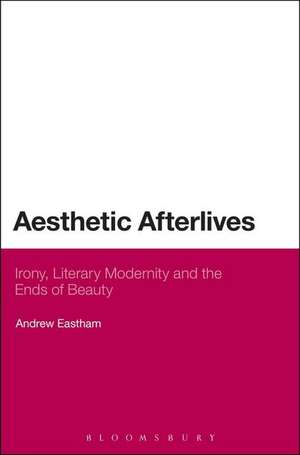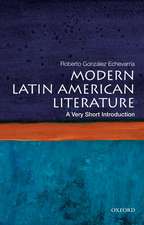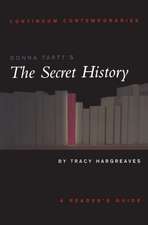Aesthetic Afterlives: Irony, Literary Modernity and the Ends of Beauty
Autor Dr Andrew Easthamen Limba Engleză Paperback – 24 apr 2013
Aesthetic Afterlives constructs a far-reaching theoretical narrative by positioning Victorian Aestheticism as the basis of Literary Modernity. Aestheticism's cultivation of irony and reflexive detachment was central to this legacy, but it was also the focus of its own self-critique. Anxieties about the concept and practice of irony persisted through Modernism, and have recently been positioned in Hollinghurst's work as a symptom of the political stasis within post-modern culture. Referring to the recent debates about the 'new aestheticism' and the politics of aesthetics, Eastham asks how a utopian Aestheticism can be reconstructed from the problematics of irony and aesthetic autonomy that haunted writers from Pater to Adorno.
| Toate formatele și edițiile | Preț | Express |
|---|---|---|
| Paperback (1) | 264.45 lei 6-8 săpt. | |
| Bloomsbury Publishing – 24 apr 2013 | 264.45 lei 6-8 săpt. | |
| Hardback (1) | 891.51 lei 6-8 săpt. | |
| Bloomsbury Publishing – 5 oct 2011 | 891.51 lei 6-8 săpt. |
Preț: 264.45 lei
Nou
Puncte Express: 397
Preț estimativ în valută:
50.60€ • 52.94$ • 42.04£
50.60€ • 52.94$ • 42.04£
Carte tipărită la comandă
Livrare economică 02-16 aprilie
Preluare comenzi: 021 569.72.76
Specificații
ISBN-13: 9781472512109
ISBN-10: 1472512103
Pagini: 272
Ilustrații: black & white illustrations
Dimensiuni: 156 x 234 x 14 mm
Greutate: 0.38 kg
Editura: Bloomsbury Publishing
Colecția Bloomsbury Academic
Locul publicării:London, United Kingdom
ISBN-10: 1472512103
Pagini: 272
Ilustrații: black & white illustrations
Dimensiuni: 156 x 234 x 14 mm
Greutate: 0.38 kg
Editura: Bloomsbury Publishing
Colecția Bloomsbury Academic
Locul publicării:London, United Kingdom
Caracteristici
Traces a narrative from Aestheticism to Postmodernism through a series of sustained textual readings.
Notă biografică
Andrew Eastham is a Visiting Lecturer at Royal Holloway, University of London, UK.
Cuprins
List of Abbreviations \ Introduction \ 1. Walter Pater'sAcoustic Space: 'The School of Giorgione', Dionysian Anders-streben, andthe Politics of Soundscape \ 2. Aesthetic Vampirism: The Concept of Irony inthe Work of Walter Pater, Oscar Wilde and Vernon Lee \ 3. 'Master of Irony':Henry James, Transatlantic Bildung and the Critique ofAestheticism \ 4. Irony's Turn: The Redress of Aestheticism in KatherineMansfield's Notebooks and Stories \ 5. Sacrificing Aestheticism: The Dialecticof Modernity and the Ends of Beauty in D.H. Lawrence's The Rainbow and Womenin Love \ 6. Aristocracies of Mourning: The Reconsecration of Aestheticismin Evelyn Waugh's Brideshead Revisited \ 7. Sublime Ironies: TheRemainders of Romanticism in Samuel Beckett's Trilogy and Krapp's Last Tape\ 8. Inoperative Ironies: Jamesian Aestheticism and Post-modern Culture in AlanHollinghurst's The Line of Beauty \ 9. The Aesthetic Afterlives of MrW.P. : Reanimating Pater in Twenty-first-Century Fiction \ Notes \ Works Cited\ Index
Recenzii
Aesthetic Afterlives traces the lineage of Paterian aesthetics from its incandescent impact within English fin de siècle culture to its spectral "afterimage" in modernist and postmodernist writing [.] Ambitious in scope, broadly researched and elaborately (if densely) argued, Eastham's book will prove of immense use to scholars anxious to reanimate an alternative line of influence in the history of literary modernity.
Aesthetic Afterlives makes an invaluable contribution to our understanding of Aestheticism's cultural legacy, with its powerful and eloquent account of Aestheticism's afterlives not only in literary modernism, but also in postmodernism and contemporary culture.
What is so striking about Aesthetic Afterlives is the way in which, having established some of the theoretical coordinates that formed the matrix of Aestheticism, it does justice to the rich complexity of affective and aesthetic interactions, including mourning, scorn, irony, yearning, faith and delusion, that mutate through the broad range of texts Eastham considers.
Aesthetic Afterlives makes an invaluable contribution to our understanding of Aestheticism's cultural legacy, with its powerful and eloquent account of Aestheticism's afterlives not only in literary modernism, but also in postmodernism and contemporary culture.
What is so striking about Aesthetic Afterlives is the way in which, having established some of the theoretical coordinates that formed the matrix of Aestheticism, it does justice to the rich complexity of affective and aesthetic interactions, including mourning, scorn, irony, yearning, faith and delusion, that mutate through the broad range of texts Eastham considers.















